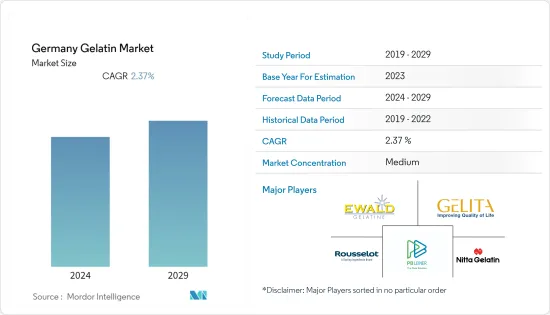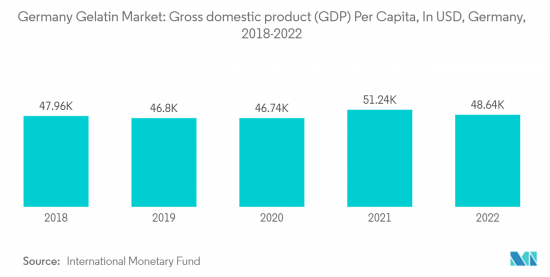PUBLISHER: Mordor Intelligence | PRODUCT CODE: 1406937

PUBLISHER: Mordor Intelligence | PRODUCT CODE: 1406937
Germany Gelatin - Market Share Analysis, Industry Trends & Statistics, Growth Forecasts 2024 - 2029

The Germany gelatin market was valued at USD 75.4 million for the current year and is projected to register a CAGR of 2.37% over the next five years.
Key Highlights
- Gelatin is widely used in the German food industry, particularly in the confectionery segment, to produce gummy candies, marshmallows, and fruit snacks. For instance, according to the Federal Office of Statistics, the revenue of the confectionery industry in Germany was EUR 16.23 billion (USD 19.15 billion) in 2022. It is also used in the cosmetic and personal care industry to manufacture face creams, lotions, and other products due to its film-forming and texturizing properties.
- Germany is a major producer of animal-based gelatin derived primarily from collagen extracted from the skin, bones, and connective tissues of livestock, such as cattle, pigs, and poultry. The animal-based gelatin production in the country is driven by the country's well-established meat and dairy industries, generating ample by-products suitable for gelatin extraction. Gelatin manufacturers in the country use advanced technologies and strict quality control measures to produce high-quality gelatin, making them competitive in the global market.
- Furthermore, Germany is also involved in marine-based gelatin production, which is derived from collagen obtained from fish skins and scales. The marine-based gelatin production is particularly relevant to its appeal to specific consumer preferences, such as those seeking halal or kosher gelatin alternatives. Marine-based gelatin is known for its low allergenicity and its compatibility with various dietary restrictions.
- In addition, according to the Organization for Economic Co-operation and Development (OCED), almost 10% of adults between the ages of 20 and 79 years had diabetes in Germany in 2022. The increase in the aging population will drive the prevalence of cardiovascular diseases (CVDs) and other chronic diseases, which ultimately increase the consumption of gelatin products to treat such diseases.
- Germany is a significant market for gelatin and plays a crucial role in both the domestic and global gelatin industries. According to the Observatory of Economic Complexity (OEC), in 2021, Germany exported USD 266 million in gelatin, making it the 2nd largest exporter of gelatin in the world.
Germany Gelatin Market Trends
Increasing Demand For Low-fat and Fat-free Food Products
- Owing to the increasing health consciousness for obesity, diabetes, and other health-related diseases, consumers are shifting toward low-calorie, fat-free food products in Germany. For instance, according to the Statistisches Bundesamt, the share of the population aged 65 years and older in 2021 in Germany was 22.1%. Gelatin plays a vital role in the preparation of low-fat or reduced-fat meals. Due to its ability to form an oil-in-water emulsion, it can be used partially to replace the high-fat content in many products.
- Without gelatin, it is hard to develop many low-fat products, such as half-fat margarine, reduced-fat cheeses, or yogurt variations. Products, such as half-fat butter, reduced-fat cheese, and fat-free ice cream gelatin, help minimize the fat content without compromising taste. In pizza cheese, for example, gelatin not only reduces the fat content but also improves the melting properties.
- Gelatin improves stability, increases shelf life, and gives the product a creamy texture. By considering its binding properties, gelatin increases the yield of cheese production and allows for cost-saving. Low doses of gelatin (0.2 to 3%) are sufficient to give dairy products the required texture.
- Furthermore, gelatin facilitates aeration, stabilizes the ice cream, improves low-temperature conservation, and prevents the formation of ice crystals during long-term conservation. It also improves ice cream's resistance to temperature variations. Combined with other texturing agents, it gives the ice cream a very characteristic texture and slows the melting of the ice cream in the mouth.
- Gelatin also creates a fat-like matrix in emulsions that exhibit shear-thinning properties and fat-like creaminess. Thus, the addition of gelatin results in a smooth, creamy texture and a compatible appearance and taste. In addition to it, the rise in per capita can be considered as one of the factors contributing to the market growth. All the above-mentioned factors drive the German gelation market during the forecast period.

Increase in Production of Animal Products in Agriculture Boosts Animal-based Gelatin
- The increase in the production of animal products, such as meat and dairy, drives the demand for animal-based gelatin in Germany. Gelatin is a protein obtained from animal collagen, mainly sourced from the skin, bones, and connective tissues of livestock. As the consumption of meat and dairy products rises, there are more by-products available for gelatin production, leading to increased supply and potentially lower costs, thus boosting the market of animal-based gelatin in the country.
- Additionally, the cosmetics, personal care, food, and beverages industries often use gelatin in various products due to its unique properties as a gelling agent, stabilizer, and emulsifier. The growing demand for processed food and convenience products also boosts the market growth of animal-based gelatin in the country. For instance, according to the Federal Office of Statistics, in 2022, cosmetics generated total revenue of around EUR 6.1 billion (USD 7.198 billion) in Germany.
- Furthermore, in the food industry, gelatin is a key ingredient in making gummy candies, marshmallows, and jelly products, providing a characteristic chewy texture. Also, gelatin is used in desserts such as puddings, mousses, etc., to give them a firm and jiggly consistency. Gelatin is used in cosmetic and personal care products due to its film-forming and texturizing properties. Gelatin is used in creams, lotions, and masks due to its film-forming properties, which help to create a smooth texture on the skin. Also, gelatin is used for hair care and nail care products as it claims to improve their strength, texture, and overall health. Such properties of gelatin enhance its demand in various sectors, thus driving the market growth of the product.
Germany Gelatin Industry Overview
The German gelatin market is highly competitive due to multiple regional and multinational companies offering a wide range of products and trying to maintain their leadership position in the market studied. Major players in the market include GELITA AG, Rousselot, NITTA GELATIN, INC, PB Gelatins Gmbh, Ewald-Gelatine GmbH, Reinert Gruppe International GmbH, Tessenderlo Group, Weishardt Group, Togel Food Ingredients GmbH and, Gelatine GmbH holding a significant share of the market studied and embarking on business strategies including product innovations, partnerships, strengthening their hold over online and offline marketing, and mergers & acquisitions to expand their visibility and portfolio of offerings, thus, augmenting the growth of the market.
.
Additional Benefits:
- The market estimate (ME) sheet in Excel format
- 3 months of analyst support
TABLE OF CONTENTS
1 INTRODUCTION
- 1.1 Study Assumptions and Market Definition
- 1.2 Scope of the Study
2 RESEARCH METHODOLOGY
3 EXECUTIVE SUMMARY
4 MARKET DYNAMICS
- 4.1 Market Drivers
- 4.1.1 Growing Demand for Convenience and Processed Foods Drives Demand
- 4.1.2 Expanding Cosmetic and Personal Care Industries Utilize Gelatin for Various Purposes
- 4.2 Market Restraints
- 4.2.1 Fluctuations in Raw Material Proces Affecting Production Costs
- 4.3 Porter's Five Forces Analysis
- 4.3.1 Threat of New Entrants
- 4.3.2 Bargaining Power of Buyers/Consumers
- 4.3.3 Bargaining Power of Suppliers
- 4.3.4 Threat of Substitute Products
- 4.3.5 Intensity of Competitive Rivalry
5 MARKET SEGMENTATION
- 5.1 Form
- 5.1.1 Animal-Based
- 5.1.2 Marine-Based
- 5.2 End-User
- 5.2.1 Personal Care and Cosmetics
- 5.2.2 Food and Beverages
- 5.2.2.1 Bakery
- 5.2.2.2 Beverages
- 5.2.2.3 Condiments/Sauces
- 5.2.2.4 Confectionery
- 5.2.2.5 Dairy and Dairy Alternative Products
- 5.2.2.6 RTE/RTC Food Products
- 5.2.2.7 Snacks
6 COMPETITIVE LANDSCAPE
- 6.1 Most Adopted Strategies
- 6.2 Market Share Analysis
- 6.3 Company Profiles
- 6.3.1 NITTA GELATIN, INC
- 6.3.2 PB Gelatins Gmbh
- 6.3.3 GELITA AG
- 6.3.4 Rousselot
- 6.3.5 Ewald-Gelatine GmbH
- 6.3.6 Reinert Gruppe International GmbH
- 6.3.7 Tessenderlo Group
- 6.3.8 Weishardt Group
- 6.3.9 Togel Food Ingredients GmbH
- 6.3.10 Gelatine GmbH
7 MARKET OPPORTUNITIES AND FUTURE TRENDS
8 DISCLAIMER




